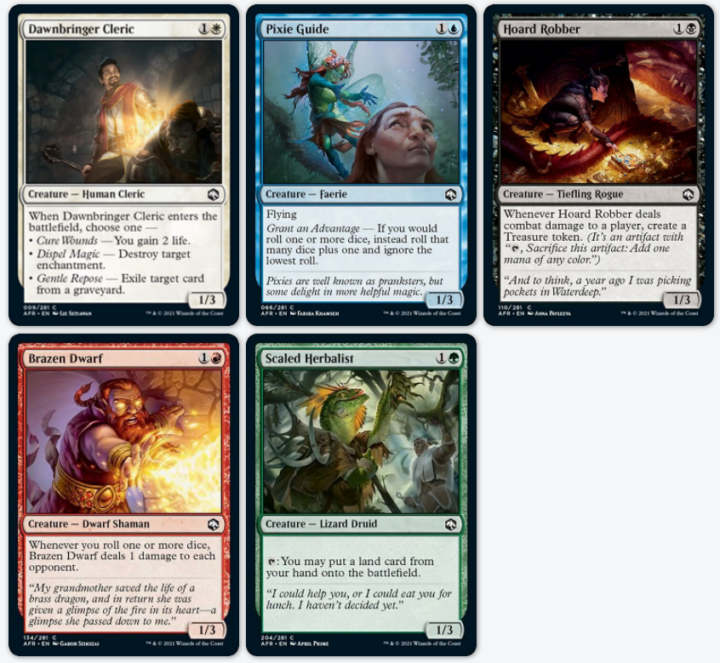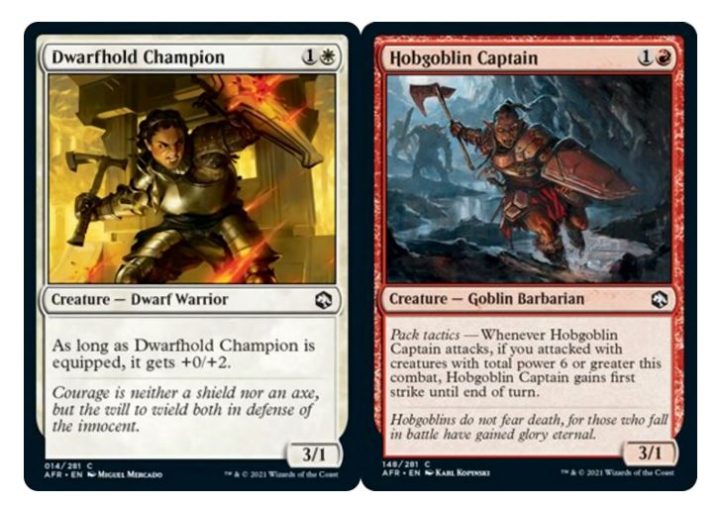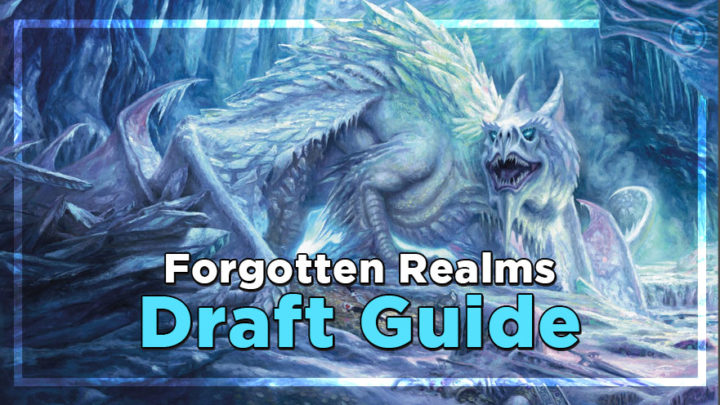Well Magic players, after 28 years, it’s finally time to party up our creatures, delve into the dungeon and have ourselves an adventure! It’s time for the Adventures in the Forgotten Realms Draft Guide!
Some people have been referring to this set as Core Set 2022 due to its place in the annual release cycle, but there is far more going on here mechanically and strategically than in those beginner-focused sets. Dungeons, lifegain triggers, die rolls and Treasure tokens make cards difficult to evaluate at first glance. The value of most commons swings wildly based on which synergies you can assemble around them, or your ability to use other cards to control the tempo of a match.
As with Strixhaven draft, there are also subtle pitfalls to avoid which can cost you severely if you go in blind with “default drafting logic,” even if you know the surface-level mechanics and archetypes for AFR. So today, I’ll be attempting to not only guide you to the best picks and most-supported strategies — I’ll also explain the metagame context that makes them good. Read the whole thing, and you’ll gain advantage on contested Draft (Magic) rolls for the rest of the set!
TIME FOR A KNOWLEDGE CHECK
Draft games in AFR are protracted, grindy affairs, dominated by high-powered bombs and mana sinks which create a resource advantage over time. Several elements of the set’s design encourage this style of game.

To start with, every color has a solid three-toughness common creature for two mana, but only white and red have two-drops with three power to punch through those — and only one each. On the whole, creatures are low-power and high-toughness, making board stalls very common.
With only a couple exceptions, the removal you might use to break these stalls is very inefficient. White and blue can have their enchantment-based removal disrupted easily by common, maindeckable answers. Green, red and especially black have to pay a couple of extra mana to achieve their usual effects. Most of these options are sorcery speed to boot!
When life gives you board stalls, it’s time to play mana sinks! Every color has ways to build an advantage without spending cards. Colorless sinks like Dungeon Map, Fifty Feet of Rope, Bag of Holding (and at rare, Dungeon Descent and Eye of Vecna) help you build extra resources over time. But there are also aggressive mana sinks to help generate pressure out of nowhere, with Equipment in every color, powerful Class enchantments to buff your creatures, and pump abilities on the creatures themselves. You need to make sure you have some sort of mana sink in basically any AFR deck, or you will give opponents a clear signal that they can stall you out.
BEST COMMONS/UNCOMMONS BY COLOR
These cards are good-to-exceptional in any deck of their color, and should be your priorities when bomb rares aren’t available.
White
Most of white’s cards are heavily specialized toward either defensive decks (UG/UB) or aggressive decks (UR), with just a short list that work well in both.
- +2 Mace
- Dwarfhold Champion
- Minimus Containment
- Rally Maneuver
- Steadfast Paladin
- Dawnbringer Cleric
- Plate Armor
Blue
Blue’s normal standbys of counterspells and flying creatures are significantly weaker here than usual. Counters in particular are only playable in very specific full control decks.
- Air-Cult Elemental
- Charmed Sleep
- Wizard Class
- Pixie Guide
- Soulknife Spy
- Trickster’s Talisman
- You Come to a River
Black
As you’d expect, black’s shortlist is dominated by the set’s best removal. Manticore is far stronger than it looks in a set with so many “wall”-style blockers, and few other flyers.
Red
All the red Goblin cards are great in their own right. With Battle Cry Goblin, they essentially become their own (exceptionally good) archetype.
- Battle Cry Goblin
- Dragon’s Fire
- Boots of Speed
- Goblin Morningstar
- Hobgoblin Captain
- Plundering Barbarian
- Swarming Goblins
Green
Green has the most consistently powerful commons, but its uncommons are lacking. You Happen On a Glade is the exception — securing your colors, your curve and a Regrowth for your bomb rares.
- Gnoll Hunter
- Owlbear
- Neverwinter Dryad
- Spoils of the Hunt
- You Happen On a Glade
- Bull’s Strength
- Lurking Roper
Multicolor/Colorless
Bruenor Battlehammer stands head and shoulders above all the other uncommon legends, worth taking early just on the off chance you can splash him alongside some Equipment. The uncommon artifacts can slide into any slow deck that still needs a mana sink/value engine.
- Bruenor Battlehammer
- Dungeon Map
- Bag of Holding
- Spiked Pit Trap
- Evolving Wilds
- Temple of the Dragon Queen
ARCHETYPE PRIMERS
Around the end of pack 1 or start of pack 2, you should be able to see which colors are offering the most powerful cards and start refining your picks around one of these two-color archetypes.
Blue-White: Venture Control
The venture mechanic will be present in almost every AFR draft deck, but UW gives you some of the best chances to really focus on it. Compared to white and black, blue’s cards tend to give more guaranteed venture triggers, but fewer extra rewards for actually completing a dungeon. This means you will often want to attempt Dungeon of the Mad Mage for maximum payoff, slowly ticking off floors as you resolve counterspells and sink excess mana. More aggressive builds are possible with the right rares or a splash to red.
Trademark cards: Cloister Gargoyle, Delver’s Torch, You Hear Something on Watch, Bar the Gate, Secret Door, Fifty Feet of Rope
White-Black: Dungeon Speedrun
Also in the Esper dungeon-venturing business, white-black has far better aggro options as well as more ways to benefit from finishing the dungeon. You’re going to want to choose Lost Mine of Phandelver, or Tomb of Annihilation when you’re ahead — the 4/4 token from the latter is game-swinging, not to mention the 3-5 damage it deals. Because most of the venture cards here either trigger through combat or benefit attacking, you need to avoid going too deep on expensive removal and slow value cards — pick up Equipment and discard instead.
Trademark cards: Grim Wanderer, Precipitous Drop, Cloister Gargoyle, Planar Ally, Thieves’ Tools, Yuan-Ti Fang-Blade
Blue-Black: Rogues/Control
Probably the closest thing to a purely reactive deck, as black has more removal and fewer mana sinks compared to white. Prioritize cards which trade one for one, and then look for a way to pull ahead. You’ll either focus on Class enchantments and artifacts like Dungeon Map, or clearing a path for creatures with beneficial “combat damage to a player” effects. It may be worth splashing for extra good removal to make sure you have enough — black generates a lot of Treasure to help with this.
Trademark cards: Eyes of the Beholder, Aberrant Mind Sorcerer, Shortcut Seeker, You Find the Villains’ Lair, Sudden Insight, Krydle of Baldur’s Gate
White-Red: (Equipment) Aggro
White-red is the deck in this set that keeps everyone else honest, punishing durdly starts and running over players with its secret weapon: the only three-power two-drops in the set.

The important thing to know is that less than a handful of commons or uncommons below five mana can trade with these on defense — and that’s before you flash in an Equipment, combat trick or removal spell for easy blowouts. This is one case where I do recommend grabbing these commons over off-color rares in most cases. You always want to be creature-heavy, so make some tough decisions about whether to use your other slots on removal, Equipment or tricks — there’s a lot of options. I tend to prefer Equipment (with a nod to the comeback potential of Rally Maneuver); you get the most flexibility in longer games, and there are excellent uncommon payoffs.
Trademark cards: Leather Armor, Ingenious Smith, You See a Pair of Goblins, Ranger’s Hawk, Tiger-Tribe Hunter, You Come to the Gnoll Camp
White-Green: Lifegain Midrange
One of the most consistent decks to shoot for, in my experience. Green has almost all playable commons, and the white cards you want tend to not be contested by other white decks. Trelasarra, Moon Dancer and Celestial Unicorn will often wheel, letting you use early picks on generally great cards like Owlbear. Cleric Class is your other major payoff, but you’ll have to grab that one early — it’s the green light to draft this great deck. Strategically, you just want to play all the best creatures you can to gum up the board until you can safely overwhelm the opponent. If you don’t have enough wincons, adding some Equipment or team-pump spells (You Hear Something on Watch, You Meet in a Tavern) should still work out.
Trademark cards: Trelasarra, Moon Dancer, Cleric Class, Celestial Unicorn, Prosperous Innkeeper, Sylvan Shepherd, Priest of Ancient Lore
Blue-Green: Ramp and Value
Nothing original here with the UG theme, although it does feel a little different in a set where nine out of ten decks are playing some sort of value game. UG has one of the strongest top-ends and the easiest time getting there out of any deck, with consistent access to extra life, cards and mana. Make sure to prioritize removal and blockers with 4 or more toughness to maximize your chances of grinding the board to a halt. Compelled Duel and Bull’s Strength are both surprisingly consistent as removal options, if you can’t get Spoils of the Hunt. The ramp tier list is Neverwinter Dryad > Dungeon Map > Treasure >>> everything else.
Trademark cards: Displacer Beast, Clever Conjurer, Rimeshield Frost Giant, Split the Party, Gretchen Titchwillow, Druid Class, Underdark Basilisk
Black-Green: Morbid Grindfest
Another green midrange deck leaning on that color’s excellent creatures, except here you also get black’s unparalleled (if expensive) removal! There’s even a few standout additions black lends to the creature curve, particularly those which generate value from creatures dying while also playing great defense. This set has fewer sac effects than usual (Neverwinter Dryad is a must-have), so you end up leaning on “chump attacks” with smaller creatures, where the opponent has to choose between letting you whittle them away or giving up easy triggers. You also have great splash potential, playing the long game with access to both Treasure and You Happen on a Glade.
Trademark cards: Yuan-Ti Fang-Blade, Inspiring Bard, Loathsome Troll, Herald of Hadar, Deadly Dispute, Shessra, Death’s Whisper
Black-Red: Treasure Control
If you’re looking for the set’s most unique and novel contribution to Limited Magic, look no further than RB. This color combo can have a solid aggro plan, since Sepulcher Ghoul and Lightfoot Rogue can just about keep pace with Dwarfhold Champion. However, everything else in black is heavily skewed toward the long game: defensive stat lines, resource-trading effects, and expensive spells in general. With these two colors having the most special synergy around Treasure and the two best removal suites, the best approach is to focus on those reactive aspects first. As with UB, you can then pick your preferred wincons: tempo two-drops, expensive finishers, or non-creature mana sinks.
Trademark cards: Reaper’s Talisman, Hoard Robber, Mimic, Skullport Merchant, Eyes of the Beholder, Rust Monster, Hoarding Ogre
Blue-Red: Die-Roll Tempo
It’s important to recognize the significance of the various “roll a d20” cards. With a few exceptions, the result of the die tends not to change the valuation of the card. Sylvan Shepherd will always generate a lifegain trigger, Herald of Hadar will always deal two damage, Spiked Pit Trap will always kill the target, etc. What matters is that you rolled a die at all; like the GW lifegain deck, the UR deck uses these triggers as fuel for a potent tempo-aggro engine. To clarify, I mean a style of deck where you start attacking as soon as possible for whatever damage you can, then keep the opponent from blocking effectively through bounce, removal, combat tricks and counterspells until they collapse. Any expensive spells in the deck should have immediate impact — such as removal. You can also add a good black splash to this theme; Herald of Hadar and Lightfoot Rogue offer repeated die roll triggers, and the discard options are at their best here.
Trademark cards: Djinni Windseer, Feywild Trickster, Chaos Channeler, Soulknife Spy, Barbarian Class, Brazen Dwarf, Farideh’s Fireball
Green-Red: Gruul Pack
As you might be able to piece together, the green-red deck uses red’s strong aggressive cards and green’s rock-solid midrange shell to simply play a non-stop curve of aggressive creatures. However, AFR’s version of the archetype has an unusual amount of utility and sub-themes available, ensuring no two RG decks are built or played exactly alike. The most important part of drafting this deck is finding a strong through-line of synergy: green and red are the most heavily contested colors in general, and grabbing random scraps will result in a hopeless mess of die-roll cards, Goblin synergies, and ramp payoffs. For my money, Barbarian Class is a reliable go-to option, although the mostly-red Battle Cry Goblin deck is always tops, where available. No matter what, keep an eye out for ways to give your huge green creatures trample — only Owlbear has it by default!
Trademark cards: You Meet in a Tavern, Iron Golem, Elturgard Ranger, Jaded Sell-Sword, Compelled Duel, You Find a Cursed Idol
A FINAL TREASURE OF WISDOM
As has been standard for a long time now, the vast majority of AFR draft decks will be two colors. However, this set lacks almost any kind of off-color fixing; just two lands and one green uncommon, all of which you should pick highly. There is NO repeated source of “any color” mana, at all, at any rarity. On the flipside, almost every deck in every color has access to one-off fixing/ramp through Treasure tokens; if not through colorless removal or their own commons, then through dungeons, where it can be created on the second or third venture trigger.
The last thing to keep in mind is that the rares and mythic rares in this set vastly outpower all the durdly, board-stalling cards at common and uncommon. There are a few draft duds or so-so rares (Oswald Fiddlebender, The Book of Vile Darkness, Minion of the Mighty, Orb of Dragonkind, most of the two-color Classes), but that only makes the absurd impact of Volo, Guide to Monsters, Meteor Swarm or Westgate Regent more important. And thanks to the clunky removal, they tend to stick around. Every deck can get away with 1-3 completely off-color bombs thanks to Treasure alone — try to do this instead of a more fleshed out third color splash.
Alright, that’s all the advice I can offer you brave adventurers. You don’t level up sitting in the tavern listening to old-timers — get yourselves to that drafting table and enjoy Adventures in the Forgotten Realms!

Tom’s fate was sealed in 7th grade when his friend lent him a pile of commons to play Magic. He quickly picked up Boros and Orzhov decks in Ravnica block and has remained a staunch white magician ever since. A fan of all Constructed formats, he enjoys studying the history of the tournament meta. He specializes in midrange decks, especially Death & Taxes and Martyr Proc. One day, he swears he will win an MCQ with Evershrike. Ask him how at @AWanderingBard, or watch him stream Magic at twitch.tv/TheWanderingBard.

